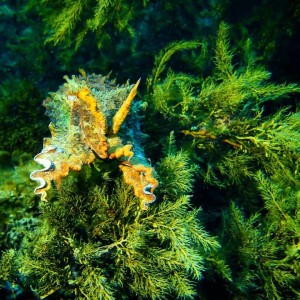
Cuttlefish in Whyalla
When you think of diving holidays in Australia, one of your highest priorities should be Scuba diving, freediving or snorkeling with the Giant Australian Cuttlefish (Sepia apama), during their annual breeding congregation. Every year, these magnificent and bizarre creatures come to Whyalla from all over the southern coastline and put on one of the most impressive, wild and fascinating displays seen in nature.
The Dive Shack dive club runs an annual cuttlefish trip from Adelaide to dive with these wonderful creatures, and this year proved to be a memorable weekend indeed. When we arrived on Friday afternoon, there was a gale blowing, but we were relying on the forecast prediction of light winds for the Saturday to make diving possible. We stayed in the heritage listed Pt Lowly lighthouse keepers cottage, built in 1883. The wind made for a slightly spooky but very atmospheric evening. It set the scene for a glorious weekend full of laughter, cheer and cuttlefish.

Two rival male cuttlefish size each other up for battle
We woke up Saturday morning pleased to see the wind starting to die down. By midday the sea was flat as anything and perfect conditions for diving. We geared up in all of the neoprene we could find, and stepped into the water. It was great to have a combination of PADI Open Water Divers, Advanced Divers, Dive Masters, Instructors, and freedivers all experiencing the visuals together. The cuttlefish put on an incredible show for us.

Two cuttlefish locked in battle. The Ink cloud is evidence of the level of distress seen in the weaker male.
Living for only one year, cuttlefish have high stakes during the breeding season. Interactions can turn fierce as males compete for females, and visual contests can sometimes end in violent clashes. On several occasions we saw a male take a chunk out of a rival with his beak.

A cuttlefish camouflages with the background
The largest cuttlefish species in the world, adult Sepia apama can grow to over 1m in mantle length. Their skin is covered in tiny coloured cells called chromatophores. They can control their colour by contracting and expanding the membranes around these cells. Their control is so precise they can make waves and flashes appear to flow through their skin. They have special “w” shaped pupils high on their head to pick up all of the visuals. If a male sees a female he will show an attraction display to grab her attention. When a rival male comes near, he will flash aggression signals. If he has a male on one side and a female on the other he will split his colouration down the middle and show half and half! They can even change the texture of their skin, and will take on the exact camouflage of their background when trying to hide. They truly are the chameleons of the sea.

Getting the fire going after a cold dive
After our dive we all went back to our accommodation, had gloriously hot showers and set about building the campfire and cooking up a storm. Mulled wine, a BBQ and a multitude of salads and desserts made for a wonderful evening. Stories were told around the campfire, and we all went to bed tired but happy.

Sunset at the Point Lowly lighthouse cottages
The next morning I went out with two divers who’d come in the evening for a quick early dive before the wind picked up. The cuttlefish were very active in the morning and we got some great photos.
We’re all looking forward to next year when this year’s babies come back to breed!









